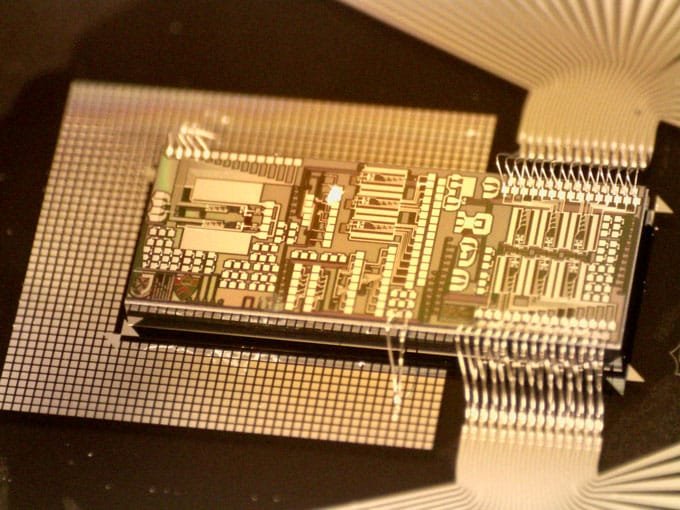Bhavin Shastri still gets excited when he sees a laser pointer, and he’s been fascinated by them since he was about 10 years old. “I was amazed that a light beam could maintain its brightness, centered in a tiny spot even after traveling a great distance,” Shastri says. “A laser pointer in my hand felt like a lightsaber from Star Wars.”
Now a physicist and engineer at Queen’s University in Kingston, Canada, Shastri wants to create light-based — or photonic — computers. And he wants them to mimic the human brain.
Standard computers rely on electricity, using wires to transmit data via electric currents. Photonic computers instead rely on light in the form of laser beams. Filters along the way alter the intensity of the light to perform calculations.
Though researchers have used light to transmit, store and process data in the lab, photonic computing is still in its infancy. Shastri has set out to push those boundaries. His photonic computer chips pack together and connect photonic components that behave like the brain’s neurons, creating a physical neural network on a chip. “The physics emulates the biology,” Shastri says.
These types of chips are more powerful for certain applications and could be a big boon for AI.

Modeling computers as brains
Shastri’s interest in light started young. He recalls an experiment that he saw as a child: A plastic water bottle was punctured near its base such that a steady stream of water flowed out and downward under the force of gravity. A laser shined through the hole in the bottle and, to Shastri’s amazement, it didn’t continue on a horizontal path. Instead, the beam bent downward with the stream of water. “I was just so completely blown away by this experiment,” he says.
Since then, Shastri has been thinking about how light can be manipulated, while also exploring other research interests. In college, he worked with a professor who was researching machine learning and artificial intelligence, which sparked a new passion. Later, as a postdoc at Princeton University, Shastri met optical physicist Paul Prucnal, who would serve as Shastri’s adviser.
Prucnal told Shastri about his research creating “a laser that behaves like a biological neuron,” Shastri says, and how the team was looking to use such a laser to compute with light. That idea caught Shastri’s attention.
Shastri was “the first to connect the dots,” Prucnal says, when he realized that photonics could push past some serious limitations of electronics.
Standard computers are “reaching their fundamental limits,” Shastri says. When most modern computers compute, they cannot simultaneously access the bulk of their memory, and when they are retrieving information from memory, they cannot calculate. This makes the computers slow and unwieldy for AI, image processing and other computations with high processing demands. Training and running today’s AI algorithms consume a vast amount of energy — collectively, predicted to demand about as much as Japan’s total electricity consumption by 2026. Computers with architectures that mimic the brain, or neuromorphic computers, promise to be faster and spend less energy.
“We want to build machines that will be much more energy-efficient and much faster than other computers,” Shastri says.
But cramming enough wires on a chip to form a brainlike web of connections for use in an electronic computer isn’t easy. Electric currents in close proximity will exert unwanted magnetic forces on one another, resulting in overheating and erratic performance. Light, however, doesn’t typically interact with other light. Thus, countless light beams of different wavelengths can pass along the same path simultaneously without any issues.
Prucnal notes that Shastri was the first to successfully create neuromorphic photonic computers on a chip. “Bhavin was pioneering a way of thinking,” he says.
Studying the light
A self-described “hardcore experimentalist,” Shastri designs, engineers, builds and performs experiments on chip-sized photonic devices. His team began by studying simpler devices akin to a single neuron, analyzing how they could mimic the function of a biological neuron. Years later, in a yet-to-be-published work, the researchers have preliminarily demonstrated that a chip with 100,000 neuronlike components can perform 120 billion operations per second, says Shastri — about 40 times faster than the average electronic computer.
Daniel Brunner, a machine learning and computing researcher at FEMTO-ST Institute in France who met Shastri when they were both postdocs, praised Shastri’s groundbreaking work. “I can’t even count the publications where he basically laid the foundation” for using photonics to create physical neural networks, Brunner says.
And Shastri’s brilliance goes beyond his “incredible energy” and “incredible capability,” Prucnal says: Shastri is able to bring people together. “It’s not just being likable, but it’s having a vision for how to [unite] these various fields,” he adds.
Still, don’t expect a photonic neuromorphic computer in your home anytime soon. These computers are more suited for specific research or industry applications. In addition to AI, Shastri and his colleagues are working on applications that include long-standing problems in radio signal optimization and image processing.
Shastri may be set on transforming computing, but his work is motivated by a decades-old fascination with light and its properties. “I have been very lucky to be able to do something,” he says, that “has always been my childhood dream.”
#engineers #lightbased #computers #inspiration #brain
Image Source : www.sciencenews.org
